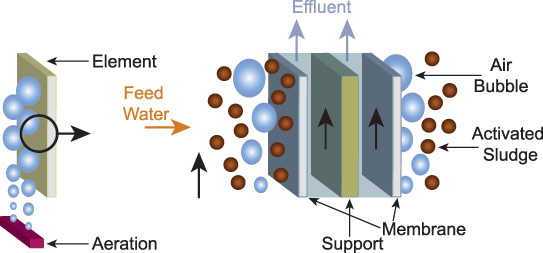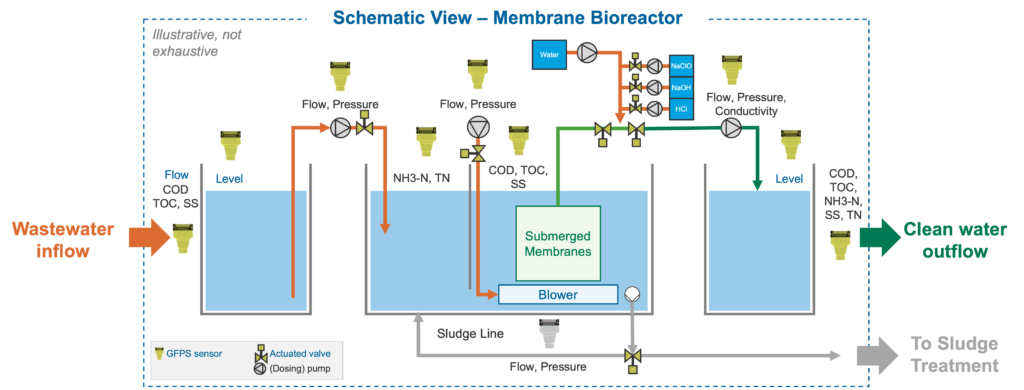The Role of Membrane Bioreactor in Achieving Higher Effluent Quality Standards
The Role of Membrane Bioreactor in Achieving Higher Effluent Quality Standards
Blog Article
Membrane Bioreactors Explained: Efficient Solutions for Clean Water
Membrane layer bioreactors (MBRs) have actually emerged as a sophisticated solution for dealing with the pressing obstacles of wastewater therapy - Membrane Bioreactor. By integrating organic processes with sophisticated membrane layer purification, MBRs not just improve the top quality of cured water yet also reduce the spatial needs of therapy facilities.

What Are Membrane Layer Bioreactors?
Membrane layer bioreactors (MBRs) are innovative wastewater therapy systems that integrate biological degradation procedures with membrane layer filtering technology. This combination enables the efficient removal of impurities from water, making MBRs a favored choice in numerous applications, including municipal wastewater therapy and commercial effluent management.

Among the important advantages of MBRs is their capacity to produce high-quality effluent, usually suitable for reuse in irrigation or commercial procedures. Furthermore, MBRs need a smaller footprint contrasted to traditional therapy systems, making them optimal for urban setups where space may be restricted.
Furthermore, MBRs can properly deal with differing influent loads and are less at risk to the effects of hazardous shocks. These characteristics add to their expanding appeal as a lasting service for resolving the increasing demand for clean water while decreasing ecological impacts.
Just How Membrane Layer Bioreactors Work
While the operation of membrane bioreactors (MBRs) may appear facility, it essentially focuses on the harmony in between biological processes and membrane filtering. MBRs incorporate an organic therapy procedure, usually activated sludge, with a membrane layer splitting up device to deal with wastewater efficiently.
In an MBR system, wastewater is first introduced into a bioreactor where microorganisms break down natural issue and various other impurities. The organic task minimizes the focus of toxins while advertising the development of biomass. Following this organic treatment, the blended liquor goes through membrane filtration, which can be microfiltration or ultrafiltration, depending on the desired effluent quality.
The membranes serve as a physical barrier, enabling water and little solutes to pass while maintaining put on hold solids and bigger molecules. This allows the system to preserve a high concentration of biomass within the reactor, enhancing the therapy performance.
Moreover, the constant separation of treated water from the biomass assists in a portable layout and lessens the footprint of the treatment facility. Overall, the mix of organic deterioration and membrane filtration in MBRs causes effective and dependable wastewater therapy, guaranteeing premium effluent suitable for numerous applications.
Advantages of MBR Technology
Among the essential benefits of membrane bioreactor (MBR) modern technology is its capability to produce high-grade effluent with a dramatically minimized footprint contrasted to conventional wastewater therapy methods. MBR systems properly integrate organic treatment and membrane layer filtration, causing exceptional elimination of pollutants, consisting of suspended solids, virus, and natural issue. This capacity results in effluent that often satisfies or exceeds rigid governing requirements for reuse and discharge.
In addition, MBR technology enables for greater biomass concentrations, which improves the therapy his comment is here performance and decreases the needed activator volume. This small layout is particularly useful in city areas where area is restricted. The functional flexibility of MBR systems likewise indicates they can adjust to varying influent high qualities and flow prices, making them ideal for a large range of applications.
Furthermore, the reduced sludge manufacturing connected with MBR procedures adds to reduce functional and upkeep prices. The membranes function as a physical barrier, lessening the threat of obstructing and making it possible for longer operational periods in between cleansing. Overall, the advantages of MBR technology make it an appealing option for sustainable wastewater treatment, attending to both ecological worries and the requirement for effective source administration.
Applications of Membrane Bioreactors
With their flexibility and effectiveness, membrane bioreactors (MBRs) find applications across various sectors, consisting of metropolitan wastewater therapy, commercial processes, and even water reclamation. In municipal setups, MBRs supply a small service for treating wastewater, effectively getting rid of impurities while concurrently creating top notch effluent that satisfies strict regulatory standards. This makes them specifically appropriate for areas with minimal room.
In commercial applications, MBR technology is made use of for dealing with process water, useful content particularly in sectors such as food and beverage, drugs, and petrochemicals. These sectors take advantage of MBRs' ability to take care of high organic loads and their performance in recuperating valuable sources from wastewater, such as nutrients and water.
Furthermore, MBRs play an essential duty in water improvement campaigns, allowing the reuse of treated wastewater for watering, industrial processes, or perhaps as drinkable water after further therapy (Membrane Bioreactor). Their efficiency in eliminating pathogens and contaminants makes them a trustworthy choice for making certain water high quality in numerous reuse applications
Future of Water Treatment Solutions
The future of water therapy solutions is positioned for transformative advancements driven by technological technology and enhancing ecological awareness. As worldwide water deficiency becomes a pressing concern, brand-new approaches, consisting of membrane layer bioreactor (MBR) systems, are set to play a crucial role in improving the effectiveness and sustainability of water therapy processes.
Emerging innovations such as expert system and artificial intelligence are anticipated to optimize treatment operations, enabling for real-time surveillance and anticipating maintenance. This will boost the total reliability and efficiency of water treatment centers. Developments in membrane materials, such as graphene and nanofiltration, promise to enhance permeation rates and decrease fouling, leading to lower energy consumption and functional prices.
In addition, the combination of sustainable energy sources right into water therapy plants will add to greener techniques. The round economic climate model will certainly likewise acquire traction, urging the healing of important sources from wastewater, such as nutrients and power.
Final Thought

Membrane layer bioreactors (MBRs) have arised as a sophisticated remedy for dealing with the pushing challenges of wastewater therapy. By integrating biological procedures with advanced membrane layer filtration, MBRs not only boost the high quality of cured water but likewise lower the visite site spatial demands of therapy centers.One of the essential benefits of membrane layer bioreactor (MBR) technology is its capability to generate top quality effluent with a dramatically decreased impact contrasted to conventional wastewater treatment techniques.With their adaptability and efficiency, membrane bioreactors (MBRs) discover applications throughout numerous sectors, including local wastewater therapy, commercial processes, and even water improvement.In final thought, membrane layer bioreactors stand for a substantial advancement in wastewater treatment technology, integrating biological processes with effective membrane filtering to generate high-grade effluent.
Report this page